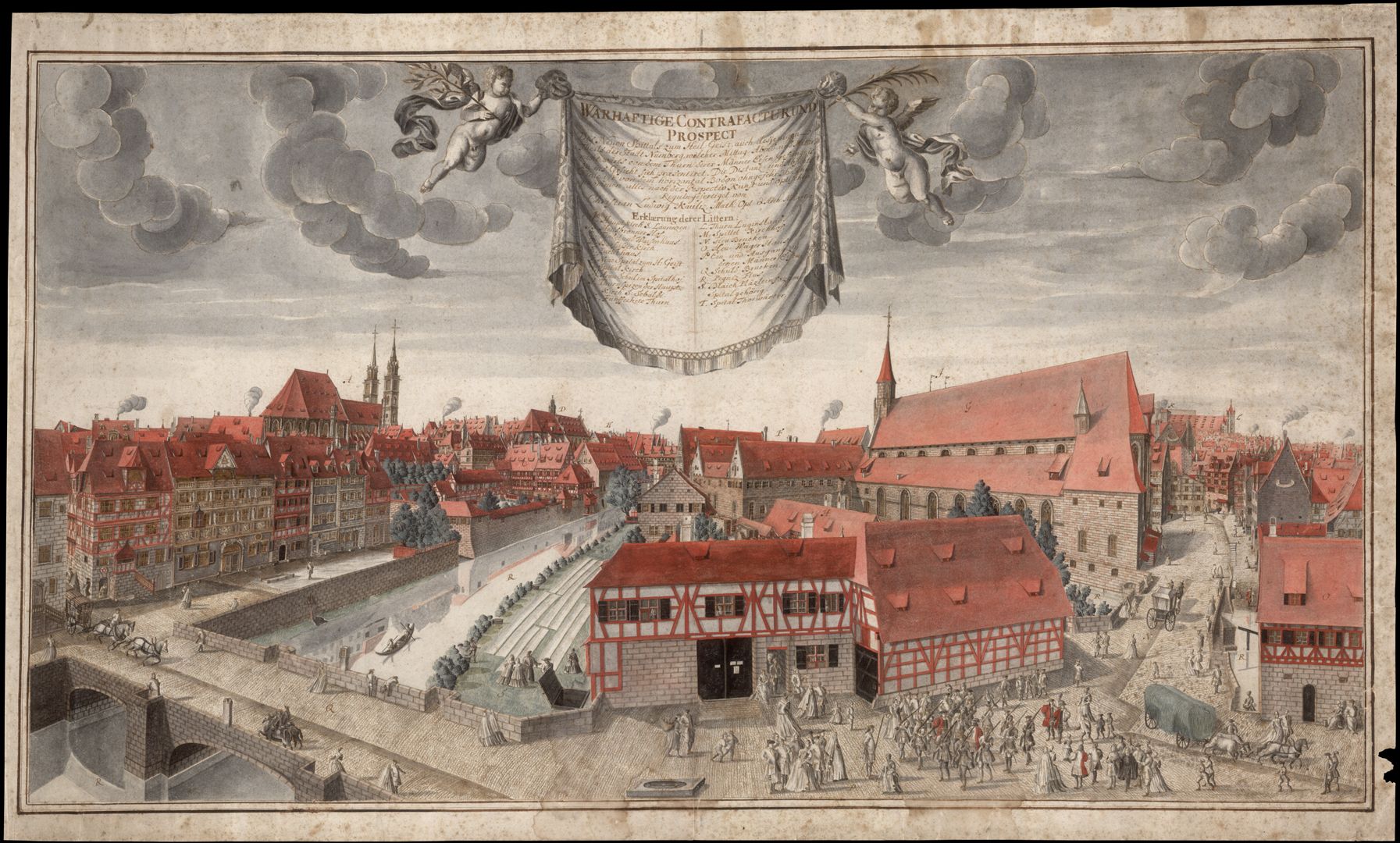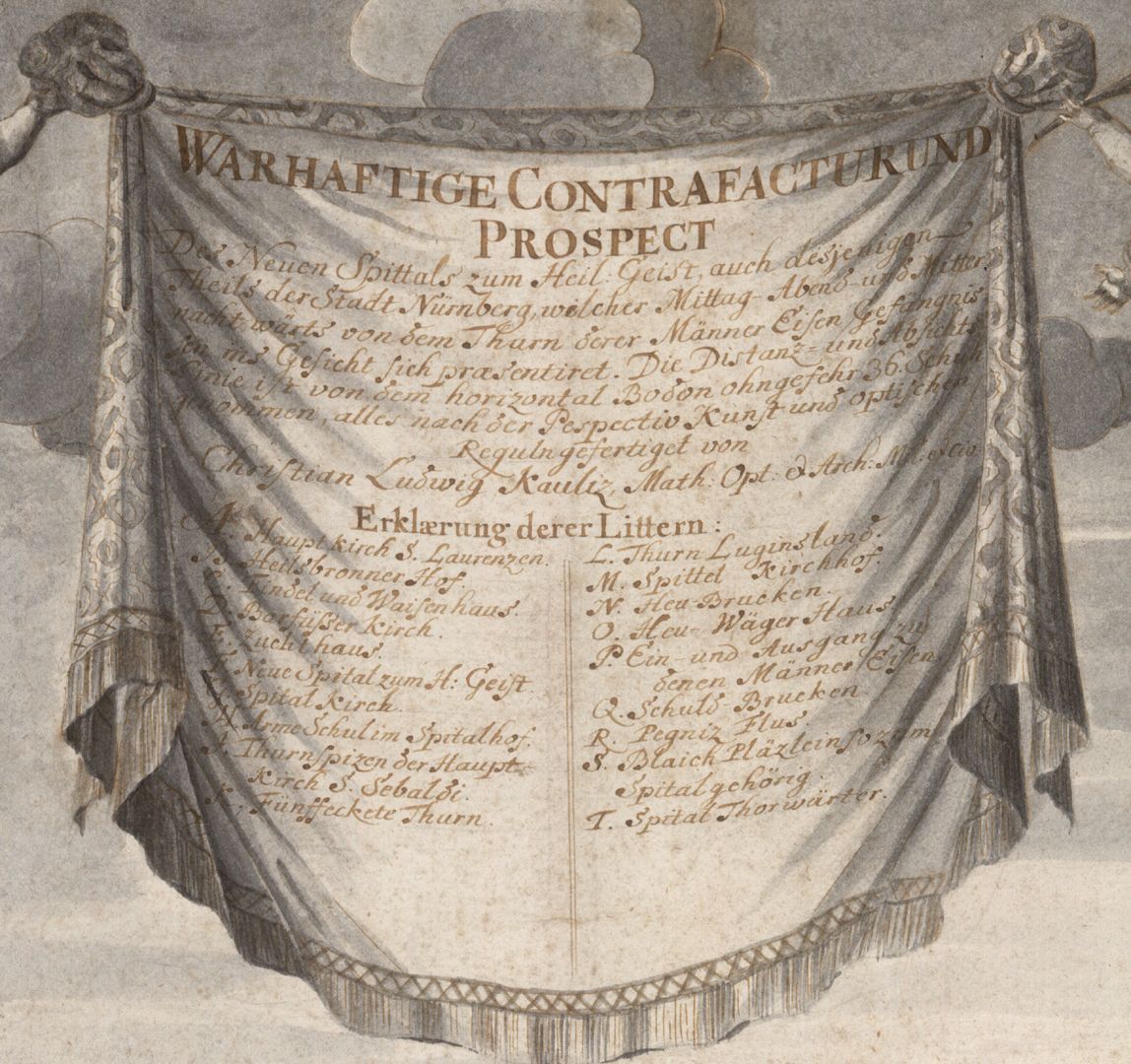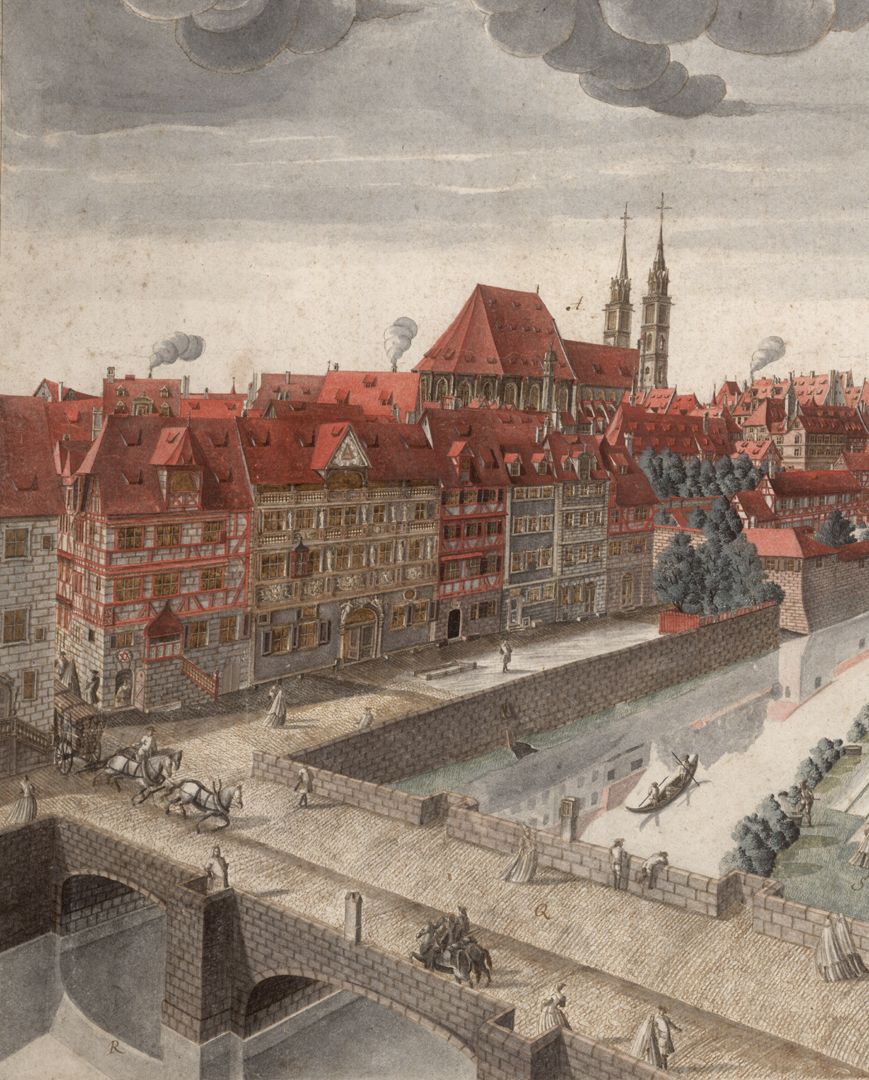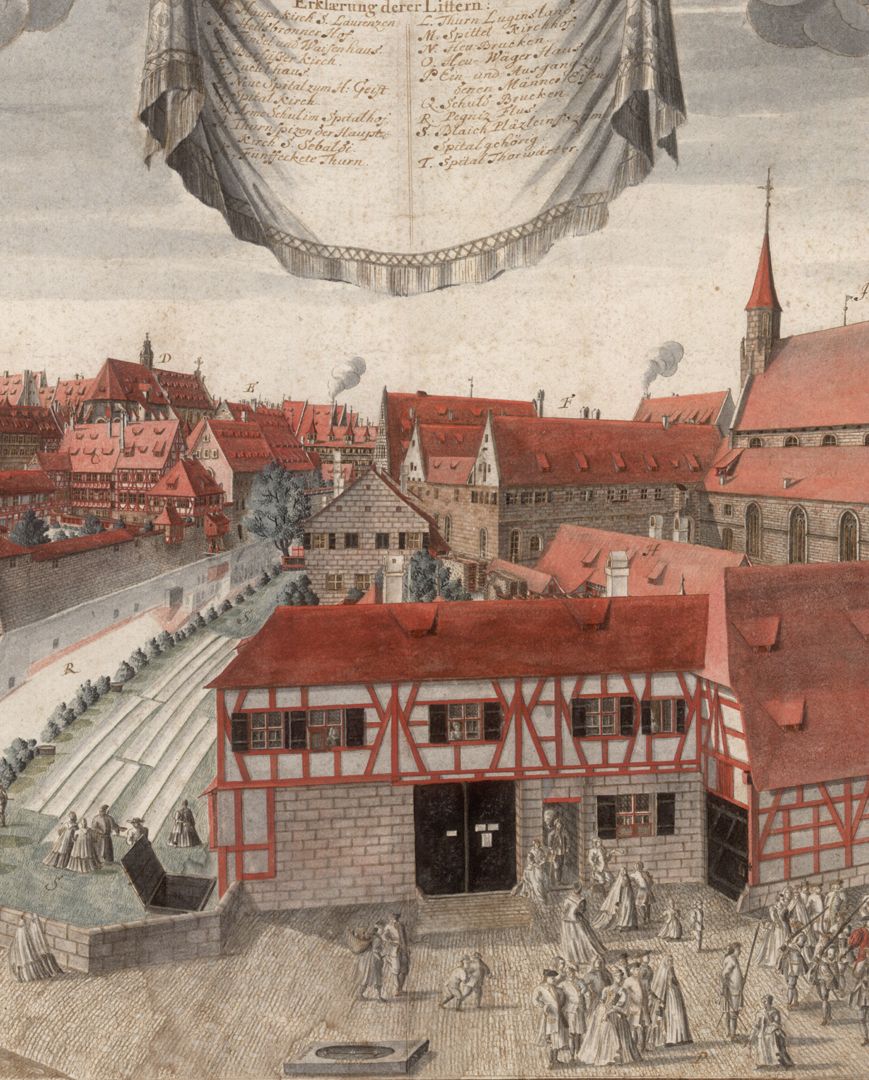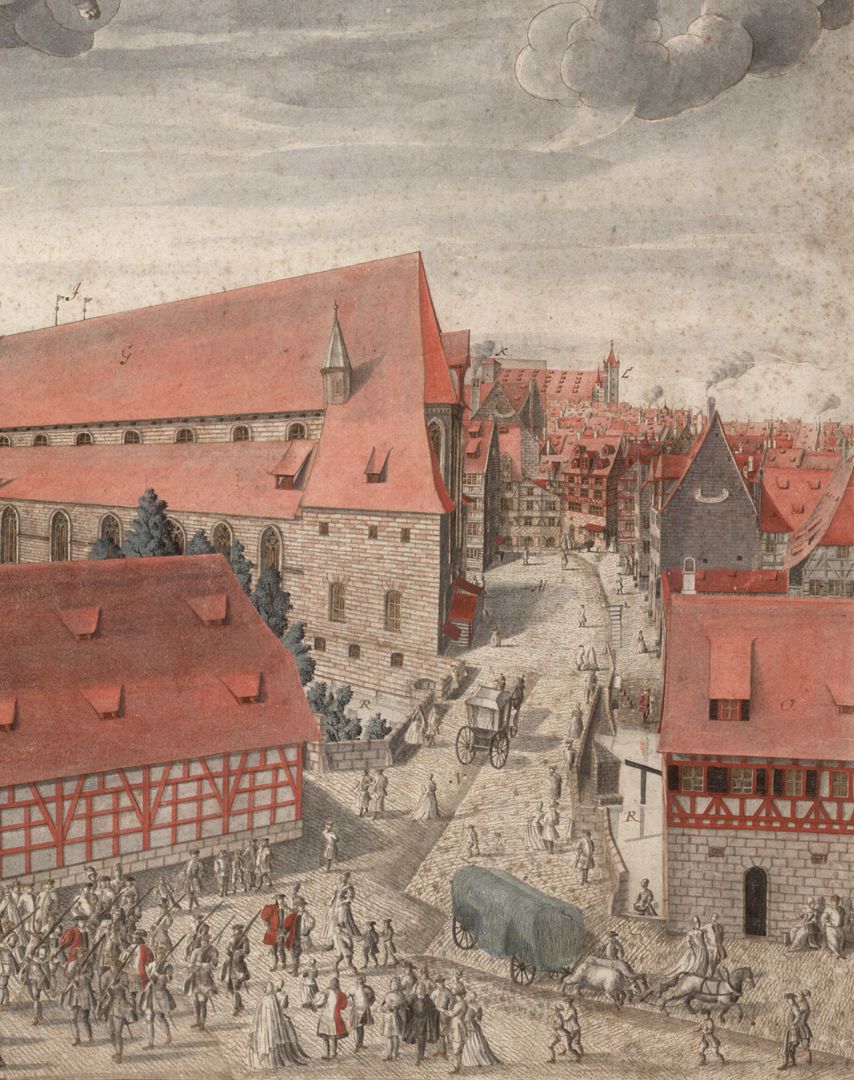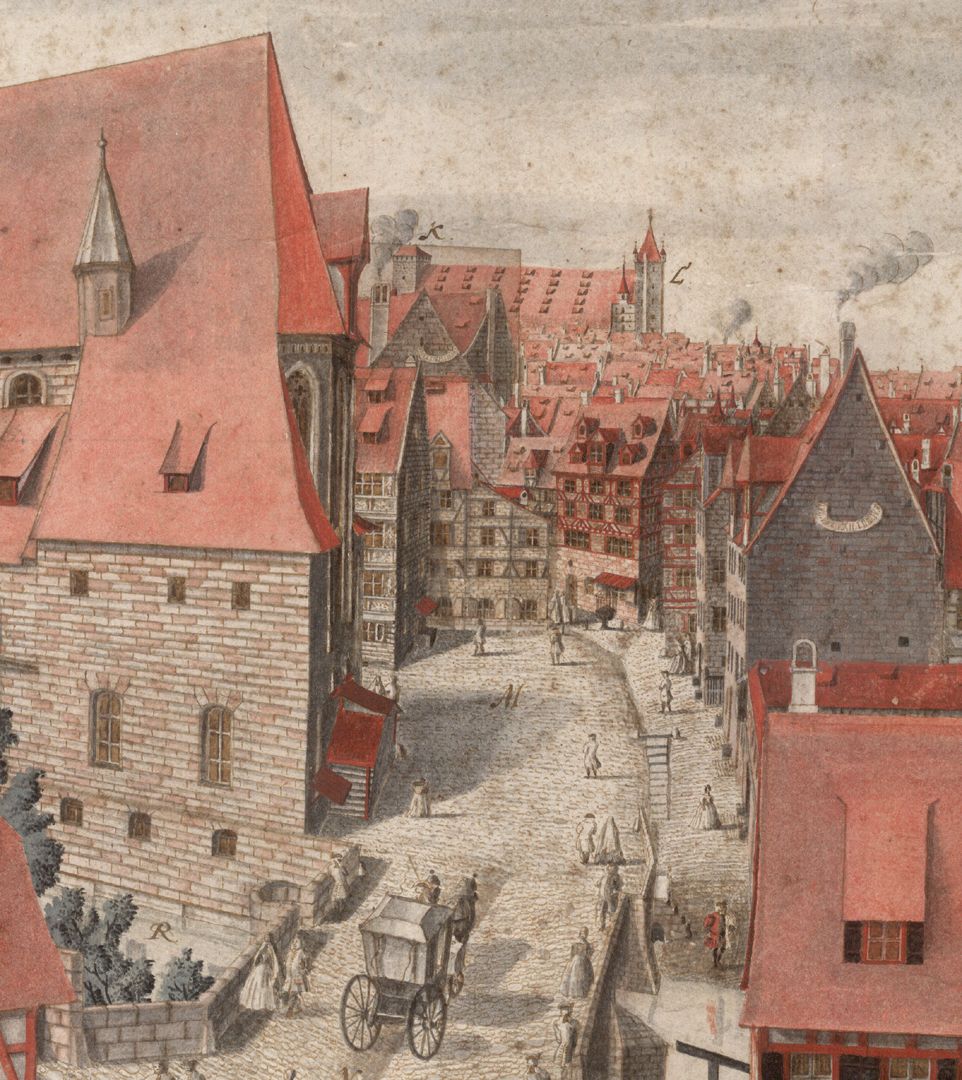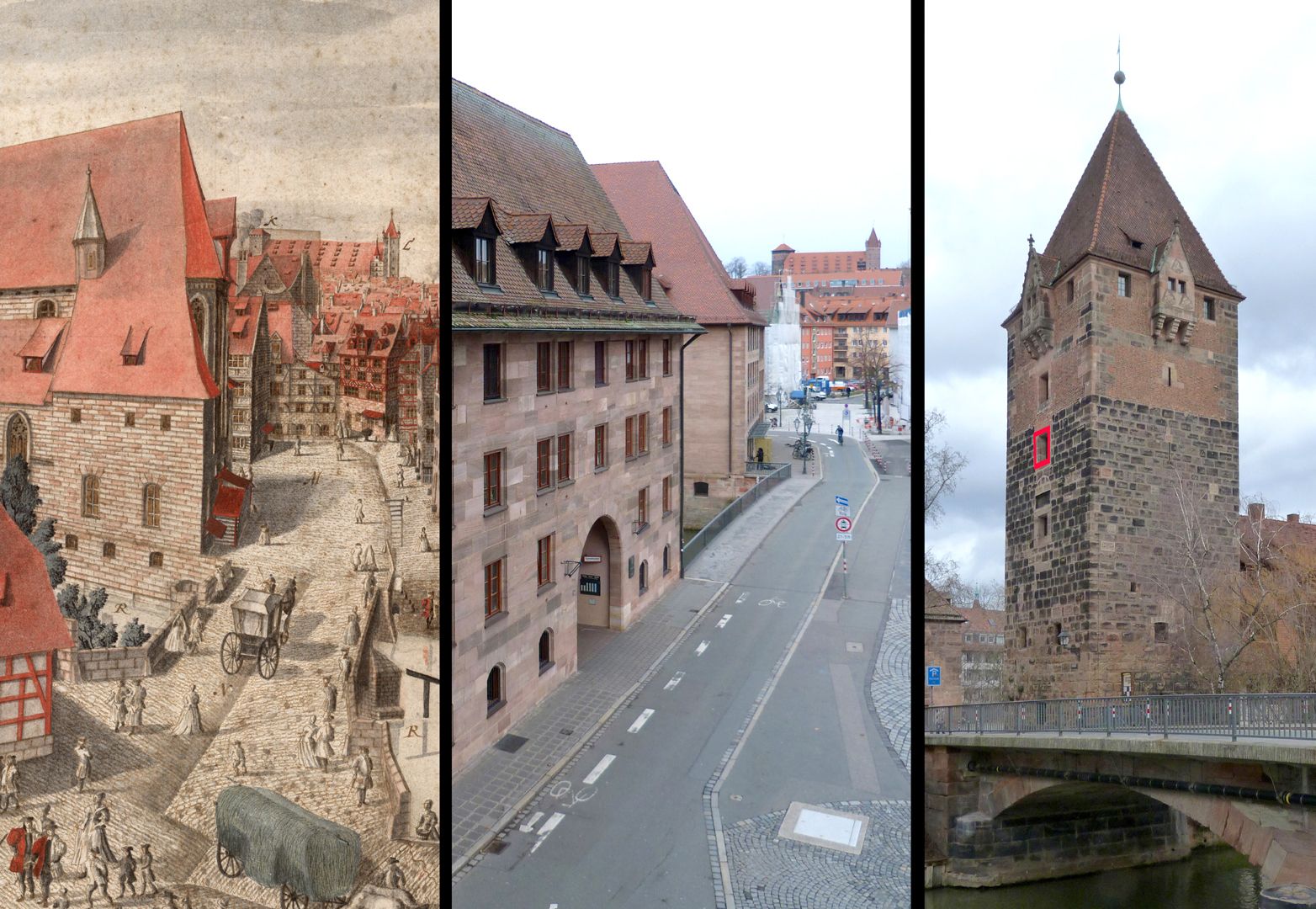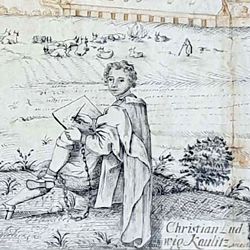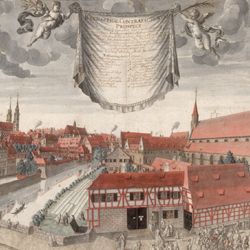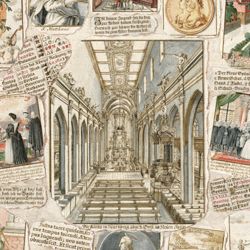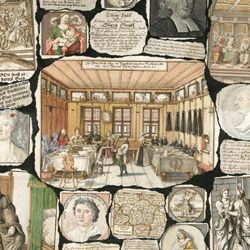Holy Spirit Hospital
Holy Spirit Hospital
1731
(after 1731)
The work is already mentioned in Kaulitz's biography of 1793. "He was an excellent artist not only as a seal engraver and calligrapher, but also as a draughtsman. Thus he drew the prospect he had of the window of his prison over the city in an exceedingly deceptive and similar manner." (Journal von und für Franken, Geschichte eines Betrügers, 1793, pp. 65-78)
Kaulitz was imprisoned in the prison Männereisen (Schuldturm) on the island of Schütt at the time the paper was written. From his restricted vantage point, he was able to draw a perspective-precise city panorama. The viewer is not only given a detailed overview, but we are also shown everyday situations through the staffage, for example the person in the foreground on the right who is presented with military protection. A new inmate for the men's travel?
A caption held by angels hovers over the entire scene.
The inscription reads: "(...) all made according to Perspectiv art and optical rules by Christian Ludwig Kauliz, Math(ematicus) Opt(icus) et Arch(itectus) Mil(itaris) et Civil(is)" (Christian Ludwig Kaulitz, mathematician, optician and military and civil architect).
Theo Noll
after 1731)
The work is already mentioned in Kaulitz's biography of 1793. "He was an excellent artist not only as a seal engraver and calligrapher, but also as a draughtsman. Thus he drew the prospect he had of the window of his prison over the city in an exceedingly deceptive and similar manner." (Journal von und für Franken, Geschichte eines Betrügers, 1793, pp. 65-78)
Kaulitz was imprisoned in the prison Männereisen (Schuldturm) on the island of Schütt at the time the paper was created. From his restricted vantage point, he was able to draw a perspective-precise city panorama. The viewer is not only given a detailed overview, but we are also shown everyday situations through the staffage, for example the person in the foreground on the right who is presented with military protection. A new inmate for the men's prisonl?
A caption held by angels hovers over the entire scene.
The inscription reads: "(...) all made according to Perspectiv art and optical rules by Christian Ludwig Kauliz, Math(ematicus) Opt(icus) et Arch(itectus) Mil(itaris) et Civil(is)" (Christian Ludwig Kaulitz, mathematician, optician and military and civil architect).
Theo Noll
Location: Museen der Stadt Nürnberg, Kunstsammlungen, Inv.-Nr. St.N. 16954
Design: Kaulitz, Christian Ludwig
Realization: Kaulitz, Christian Ludwig
Material: Watercolour pen and ink drawing on paper, sheet: 47 x 78.2 cm; image: 43.4 x 76.4 cm
photo 2019,
Holy Spirit Hospital
1731
A caption held by angels hovers over the entire scene.
(after 1731)
The work is already mentioned in Kaulitz's biography of 1793. "He was an excellent artist not only as a seal engraver and calligrapher, but also as a draughtsman. Thus he drew the prospect he had of the window of his prison over the city in an exceedingly deceptive and similar manner." (Journal von und für Franken, Geschichte eines Betrügers, 1793, pp. 65-78)
Kaulitz was imprisoned in the prison Männereisen (Schuldturm) on the island of Schütt at the time the paper was written. From his restricted vantage point, he was able to draw a perspective-precise city panorama. The viewer is not only given a detailed overview, but we are also shown everyday situations through the staffage, for example the person in the foreground on the right who is presented with military protection. A new inmate for the men's travel?
A caption held by angels hovers over the entire scene.
The inscription reads: "(...) all made according to Perspectiv art and optical rules by Christian Ludwig Kauliz, Math(ematicus) Opt(icus) et Arch(itectus) Mil(itaris) et Civil(is)" (Christian Ludwig Kaulitz, mathematician, optician and military and civil architect).
Theo Noll
after 1731)
The work is already mentioned in Kaulitz's biography of 1793. "He was an excellent artist not only as a seal engraver and calligrapher, but also as a draughtsman. Thus he drew the prospect he had of the window of his prison over the city in an exceedingly deceptive and similar manner." (Journal von und für Franken, Geschichte eines Betrügers, 1793, pp. 65-78)
Kaulitz was imprisoned in the prison Männereisen (Schuldturm) on the island of Schütt at the time the paper was created. From his restricted vantage point, he was able to draw a perspective-precise city panorama. The viewer is not only given a detailed overview, but we are also shown everyday situations through the staffage, for example the person in the foreground on the right who is presented with military protection. A new inmate for the men's prisonl?
A caption held by angels hovers over the entire scene.
The inscription reads: "(...) all made according to Perspectiv art and optical rules by Christian Ludwig Kauliz, Math(ematicus) Opt(icus) et Arch(itectus) Mil(itaris) et Civil(is)" (Christian Ludwig Kaulitz, mathematician, optician and military and civil architect).
Theo Noll
Location: Museen der Stadt Nürnberg, Kunstsammlungen, Inv.-Nr. St.N. 16954
Design: Kaulitz, Christian Ludwig
Realization: Kaulitz, Christian Ludwig
Material: Watercolour pen and ink drawing on paper, sheet: 47 x 78.2 cm; image: 43.4 x 76.4 cm
photo 2019,
Holy Spirit Hospital
1731
Left third of the sheet.
(after 1731)
The work is already mentioned in Kaulitz's biography of 1793. "He was an excellent artist not only as a seal engraver and calligrapher, but also as a draughtsman. Thus he drew the prospect he had of the window of his prison over the city in an exceedingly deceptive and similar manner." (Journal von und für Franken, Geschichte eines Betrügers, 1793, pp. 65-78)
Kaulitz was imprisoned in the prison Männereisen (Schuldturm) on the island of Schütt at the time the paper was written. From his restricted vantage point, he was able to draw a perspective-precise city panorama. The viewer is not only given a detailed overview, but we are also shown everyday situations through the staffage, for example the person in the foreground on the right who is presented with military protection. A new inmate for the men's travel?
A caption held by angels hovers over the entire scene.
The inscription reads: "(...) all made according to Perspectiv art and optical rules by Christian Ludwig Kauliz, Math(ematicus) Opt(icus) et Arch(itectus) Mil(itaris) et Civil(is)" (Christian Ludwig Kaulitz, mathematician, optician and military and civil architect).
Theo Noll
after 1731)
The work is already mentioned in Kaulitz's biography of 1793. "He was an excellent artist not only as a seal engraver and calligrapher, but also as a draughtsman. Thus he drew the prospect he had of the window of his prison over the city in an exceedingly deceptive and similar manner." (Journal von und für Franken, Geschichte eines Betrügers, 1793, pp. 65-78)
Kaulitz was imprisoned in the prison Männereisen (Schuldturm) on the island of Schütt at the time the paper was created. From his restricted vantage point, he was able to draw a perspective-precise city panorama. The viewer is not only given a detailed overview, but we are also shown everyday situations through the staffage, for example the person in the foreground on the right who is presented with military protection. A new inmate for the men's prisonl?
A caption held by angels hovers over the entire scene.
The inscription reads: "(...) all made according to Perspectiv art and optical rules by Christian Ludwig Kauliz, Math(ematicus) Opt(icus) et Arch(itectus) Mil(itaris) et Civil(is)" (Christian Ludwig Kaulitz, mathematician, optician and military and civil architect).
Theo Noll
Location: Museen der Stadt Nürnberg, Kunstsammlungen, Inv.-Nr. St.N. 16954
Design: Kaulitz, Christian Ludwig
Realization: Kaulitz, Christian Ludwig
Material: Watercolour pen and ink drawing on paper, sheet: 47 x 78.2 cm; image: 43.4 x 76.4 cm
photo 2019,
Holy Spirit Hospital
1731
Central third of the sheet.
(after 1731)
The work is already mentioned in Kaulitz's biography of 1793. "He was an excellent artist not only as a seal engraver and calligrapher, but also as a draughtsman. Thus he drew the prospect he had of the window of his prison over the city in an exceedingly deceptive and similar manner." (Journal von und für Franken, Geschichte eines Betrügers, 1793, pp. 65-78)
Kaulitz was imprisoned in the prison Männereisen (Schuldturm) on the island of Schütt at the time the paper was written. From his restricted vantage point, he was able to draw a perspective-precise city panorama. The viewer is not only given a detailed overview, but we are also shown everyday situations through the staffage, for example the person in the foreground on the right who is presented with military protection. A new inmate for the men's travel?
A caption held by angels hovers over the entire scene.
The inscription reads: "(...) all made according to Perspectiv art and optical rules by Christian Ludwig Kauliz, Math(ematicus) Opt(icus) et Arch(itectus) Mil(itaris) et Civil(is)" (Christian Ludwig Kaulitz, mathematician, optician and military and civil architect).
Theo Noll
after 1731)
The work is already mentioned in Kaulitz's biography of 1793. "He was an excellent artist not only as a seal engraver and calligrapher, but also as a draughtsman. Thus he drew the prospect he had of the window of his prison over the city in an exceedingly deceptive and similar manner." (Journal von und für Franken, Geschichte eines Betrügers, 1793, pp. 65-78)
Kaulitz was imprisoned in the prison Männereisen (Schuldturm) on the island of Schütt at the time the paper was created. From his restricted vantage point, he was able to draw a perspective-precise city panorama. The viewer is not only given a detailed overview, but we are also shown everyday situations through the staffage, for example the person in the foreground on the right who is presented with military protection. A new inmate for the men's prisonl?
A caption held by angels hovers over the entire scene.
The inscription reads: "(...) all made according to Perspectiv art and optical rules by Christian Ludwig Kauliz, Math(ematicus) Opt(icus) et Arch(itectus) Mil(itaris) et Civil(is)" (Christian Ludwig Kaulitz, mathematician, optician and military and civil architect).
Theo Noll
Location: Museen der Stadt Nürnberg, Kunstsammlungen, Inv.-Nr. St.N. 16954
Design: Kaulitz, Christian Ludwig
Realization: Kaulitz, Christian Ludwig
Material: Watercolour pen and ink drawing on paper, sheet: 47 x 78.2 cm; image: 43.4 x 76.4 cm
photo 2019,
Holy Spirit Hospital
1731
Right third of the sheet. On the lower left the depiction of a person presented with military protection. A new inmate for the men's prison?
(after 1731)
The work is already mentioned in Kaulitz's biography of 1793. "He was an excellent artist not only as a seal engraver and calligrapher, but also as a draughtsman. Thus he drew the prospect he had of the window of his prison over the city in an exceedingly deceptive and similar manner." (Journal von und für Franken, Geschichte eines Betrügers, 1793, pp. 65-78)
Kaulitz was imprisoned in the prison Männereisen (Schuldturm) on the island of Schütt at the time the paper was written. From his restricted vantage point, he was able to draw a perspective-precise city panorama. The viewer is not only given a detailed overview, but we are also shown everyday situations through the staffage, for example the person in the foreground on the right who is presented with military protection. A new inmate for the men's travel?
A caption held by angels hovers over the entire scene.
The inscription reads: "(...) all made according to Perspectiv art and optical rules by Christian Ludwig Kauliz, Math(ematicus) Opt(icus) et Arch(itectus) Mil(itaris) et Civil(is)" (Christian Ludwig Kaulitz, mathematician, optician and military and civil architect).
Theo Noll
after 1731)
The work is already mentioned in Kaulitz's biography of 1793. "He was an excellent artist not only as a seal engraver and calligrapher, but also as a draughtsman. Thus he drew the prospect he had of the window of his prison over the city in an exceedingly deceptive and similar manner." (Journal von und für Franken, Geschichte eines Betrügers, 1793, pp. 65-78)
Kaulitz was imprisoned in the prison Männereisen (Schuldturm) on the island of Schütt at the time the paper was created. From his restricted vantage point, he was able to draw a perspective-precise city panorama. The viewer is not only given a detailed overview, but we are also shown everyday situations through the staffage, for example the person in the foreground on the right who is presented with military protection. A new inmate for the men's prisonl?
A caption held by angels hovers over the entire scene.
The inscription reads: "(...) all made according to Perspectiv art and optical rules by Christian Ludwig Kauliz, Math(ematicus) Opt(icus) et Arch(itectus) Mil(itaris) et Civil(is)" (Christian Ludwig Kaulitz, mathematician, optician and military and civil architect).
Theo Noll
Location: Museen der Stadt Nürnberg, Kunstsammlungen, Inv.-Nr. St.N. 16954
Design: Kaulitz, Christian Ludwig
Realization: Kaulitz, Christian Ludwig
Material: Watercolour pen and ink drawing on paper, sheet: 47 x 78.2 cm; image: 43.4 x 76.4 cm
photo 2019,
Holy Spirit Hospital
1731
View in the direction of the Holy Spirit Church and the Imperial Stables (on the upper horizon).
(after 1731)
The work is already mentioned in Kaulitz's biography of 1793. "He was an excellent artist not only as a seal engraver and calligrapher, but also as a draughtsman. Thus he drew the prospect he had of the window of his prison over the city in an exceedingly deceptive and similar manner." (Journal von und für Franken, Geschichte eines Betrügers, 1793, pp. 65-78)
Kaulitz was imprisoned in the prison Männereisen (Schuldturm) on the island of Schütt at the time the paper was written. From his restricted vantage point, he was able to draw a perspective-precise city panorama. The viewer is not only given a detailed overview, but we are also shown everyday situations through the staffage, for example the person in the foreground on the right who is presented with military protection. A new inmate for the men's travel?
A caption held by angels hovers over the entire scene.
The inscription reads: "(...) all made according to Perspectiv art and optical rules by Christian Ludwig Kauliz, Math(ematicus) Opt(icus) et Arch(itectus) Mil(itaris) et Civil(is)" (Christian Ludwig Kaulitz, mathematician, optician and military and civil architect).
Theo Noll
after 1731)
The work is already mentioned in Kaulitz's biography of 1793. "He was an excellent artist not only as a seal engraver and calligrapher, but also as a draughtsman. Thus he drew the prospect he had of the window of his prison over the city in an exceedingly deceptive and similar manner." (Journal von und für Franken, Geschichte eines Betrügers, 1793, pp. 65-78)
Kaulitz was imprisoned in the prison Männereisen (Schuldturm) on the island of Schütt at the time the paper was created. From his restricted vantage point, he was able to draw a perspective-precise city panorama. The viewer is not only given a detailed overview, but we are also shown everyday situations through the staffage, for example the person in the foreground on the right who is presented with military protection. A new inmate for the men's prisonl?
A caption held by angels hovers over the entire scene.
The inscription reads: "(...) all made according to Perspectiv art and optical rules by Christian Ludwig Kauliz, Math(ematicus) Opt(icus) et Arch(itectus) Mil(itaris) et Civil(is)" (Christian Ludwig Kaulitz, mathematician, optician and military and civil architect).
Theo Noll
Location: Museen der Stadt Nürnberg, Kunstsammlungen, Inv.-Nr. St.N. 16954
Design: Kaulitz, Christian Ludwig
Realization: Kaulitz, Christian Ludwig
Material: Watercolour pen and ink drawing on paper, sheet: 47 x 78.2 cm; image: 43.4 x 76.4 cm
photo 2019,
Holy Spirit Hospital
1731
An on-site inspection suggests that the second window below the western bay is the point of view for this drawing.
(after 1731)
The work is already mentioned in Kaulitz's biography of 1793. "He was an excellent artist not only as a seal engraver and calligrapher, but also as a draughtsman. Thus he drew the prospect he had of the window of his prison over the city in an exceedingly deceptive and similar manner." (Journal von und für Franken, Geschichte eines Betrügers, 1793, pp. 65-78)
Kaulitz was imprisoned in the prison Männereisen (Schuldturm) on the island of Schütt at the time the paper was written. From his restricted vantage point, he was able to draw a perspective-precise city panorama. The viewer is not only given a detailed overview, but we are also shown everyday situations through the staffage, for example the person in the foreground on the right who is presented with military protection. A new inmate for the men's travel?
A caption held by angels hovers over the entire scene.
The inscription reads: "(...) all made according to Perspectiv art and optical rules by Christian Ludwig Kauliz, Math(ematicus) Opt(icus) et Arch(itectus) Mil(itaris) et Civil(is)" (Christian Ludwig Kaulitz, mathematician, optician and military and civil architect).
Theo Noll
after 1731)
The work is already mentioned in Kaulitz's biography of 1793. "He was an excellent artist not only as a seal engraver and calligrapher, but also as a draughtsman. Thus he drew the prospect he had of the window of his prison over the city in an exceedingly deceptive and similar manner." (Journal von und für Franken, Geschichte eines Betrügers, 1793, pp. 65-78)
Kaulitz was imprisoned in the prison Männereisen (Schuldturm) on the island of Schütt at the time the paper was created. From his restricted vantage point, he was able to draw a perspective-precise city panorama. The viewer is not only given a detailed overview, but we are also shown everyday situations through the staffage, for example the person in the foreground on the right who is presented with military protection. A new inmate for the men's prisonl?
A caption held by angels hovers over the entire scene.
The inscription reads: "(...) all made according to Perspectiv art and optical rules by Christian Ludwig Kauliz, Math(ematicus) Opt(icus) et Arch(itectus) Mil(itaris) et Civil(is)" (Christian Ludwig Kaulitz, mathematician, optician and military and civil architect).
Theo Noll
Location: Museen der Stadt Nürnberg, Kunstsammlungen, Inv.-Nr. St.N. 16954
Design: Kaulitz, Christian Ludwig
Realization: Kaulitz, Christian Ludwig
Material: Watercolour pen and ink drawing on paper, sheet: 47 x 78.2 cm; image: 43.4 x 76.4 cm
photo 2019, Theo Noll,
